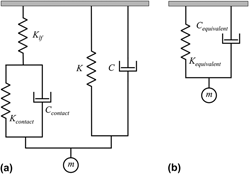Crossref Citations
This article has been cited by the following publications. This list is generated based on data provided by
Crossref.
Rinaldi, A.
Araneo, R.
Pea, M.
and
Notargiacomo, A.
2015.
Observations of nanoscale properties of ZnO pillars subject to compression.
p.
518.
Herbert, Erik G.
Sudharshan Phani, P.
and
Johanns, Kurt E.
2015.
Nanoindentation of viscoelastic solids: A critical assessment of experimental methods.
Current Opinion in Solid State and Materials Science,
Vol. 19,
Issue. 6,
p.
334.
Kim, Do-Gyoon
Jeong, Yong-Hoon
Kosel, Erin
Agnew, Amanda M.
McComb, David W.
Bodnyk, Kyle
Hart, Richard T.
Kim, Min Kyung
Han, Sang Yeun
and
Johnston, William M.
2015.
Regional variation of bone tissue properties at the human mandibular condyle.
Bone,
Vol. 77,
Issue. ,
p.
98.
Araneo, Rodolfo
Rinaldi, Antonio
Notargiacomo, Andrea
Pea, Marialilia
and
Celozzi, Salvatore
2016.
Advanced mechanical and electrical characterization of piezoelectric ZnO nanowires for electro-mechanical modeling of enhanced performance sensors.
Sensors and Actuators A: Physical,
Vol. 244,
Issue. ,
p.
166.
Weyand, Stephan
Blattmann, Hannes
Schimpf, Vitalij
Mülhaupt, Rolf
and
Schwaiger, Ruth
2016.
Structure-property-glass transition relationships in non-isocyanate polyurethanes investigated by dynamic nanoindentation.
Materials Research Express,
Vol. 3,
Issue. 7,
p.
075019.
Nyman, Jeffry S.
Granke, Mathilde
Singleton, Robert C.
and
Pharr, George M.
2016.
Tissue-Level Mechanical Properties of Bone Contributing to Fracture Risk.
Current Osteoporosis Reports,
Vol. 14,
Issue. 4,
p.
138.
Yu, Seungho
Schmidt, Robert D.
Garcia-Mendez, Regina
Herbert, Erik
Dudney, Nancy J.
Wolfenstine, Jeffrey B.
Sakamoto, Jeff
and
Siegel, Donald J.
2016.
Elastic Properties of the Solid Electrolyte Li7La3Zr2O12(LLZO).
Chemistry of Materials,
Vol. 28,
Issue. 1,
p.
197.
Golovin, Yu. I.
Korenkov, V. V.
and
Razlivalova, S. S.
2017.
The effect of small-amplitude load oscillations on the nanocontact characteristics of materials in nanoindentation.
Physics of the Solid State,
Vol. 59,
Issue. 6,
p.
1127.
Jia, Yun-Fei
Cui, Yuan-Yuan
Xuan, Fu-Zhen
and
Yang, Fuqian
2017.
Comparison between single loading–unloading indentation and continuous stiffness indentation.
RSC Advances,
Vol. 7,
Issue. 57,
p.
35655.
Merle, B.
Kraus, X.
Tallawi, M.
Scharfe, B.
El Fray, M.
Aifantis, K.E.
Boccaccini, A.R.
and
Göken, M.
2018.
Dynamic mechanical characterization of poly(glycerol sebacate)/poly(butylene succinate-butylene dilinoleate) blends for cardiac tissue engineering by flat punch nanoindentation.
Materials Letters,
Vol. 221,
Issue. ,
p.
115.
Merle, B.
and
Höppel, H. W.
2018.
Microscale High-Cycle Fatigue Testing by Dynamic Micropillar Compression Using Continuous Stiffness Measurement.
Experimental Mechanics,
Vol. 58,
Issue. 3,
p.
465.
Maxwell, Tyler L.
and
Balk, Thomas John
2019.
Understanding the Time‐Dependent Mechanical Behavior of Bimodal Nanoporous Si–Mg Films via Nanoindentation.
Global Challenges,
Vol. 3,
Issue. 7,
Bergmann, Jim A.
Kimm, Janis
Theisen, Werner
and
Wiederkehr, Petra
2020.
An approach to use sub-surface characteristics for the prediction of process forces during cutting operations.
Procedia CIRP,
Vol. 88,
Issue. ,
p.
276.
Phani, P. Sudharshan
Oliver, W.C.
and
Pharr, G.M.
2020.
Understanding and modeling plasticity error during nanoindentation with continuous stiffness measurement.
Materials & Design,
Vol. 194,
Issue. ,
p.
108923.
Watanabe, Keiichiro
Lewis, Samantha
Guo, Xiaohan
Ni, Ai
Lee, Beth S.
Deguchi, Toru
and
Kim, Do-Gyoon
2020.
Regional variations of jaw bone characteristics in an ovariectomized rat model.
Journal of the Mechanical Behavior of Biomedical Materials,
Vol. 110,
Issue. ,
p.
103952.
Papakyriakou, Marc
Lu, Mu
Liu, Yuhgene
Liu, Zhantao
Chen, Hailong
McDowell, Matthew T.
and
Xia, Shuman
2021.
Mechanical behavior of inorganic lithium-conducting solid electrolytes.
Journal of Power Sources,
Vol. 516,
Issue. ,
p.
230672.
Sudharshan Phani, P.
Oliver, W. C.
and
Pharr, G. M.
2021.
Measurement of hardness and elastic modulus by load and depth sensing indentation: Improvements to the technique based on continuous stiffness measurement.
Journal of Materials Research,
Vol. 36,
Issue. 11,
p.
2137.
Ali, Mohsin
Istif, Emin
Bathaei, Mohammad Javad
and
Beker, Levent
2023.
Investigation of dynamic micromechanical properties of biodegradable elastic material by continuous stiffness measurement analysis.
Journal of Elastomers & Plastics,
Vol. 55,
Issue. 7,
p.
1111.
Tyurin, A. I.
Korenkov, V. V.
Gusev, A. A.
Vasyukova, I. A.
and
Yunak, M. A.
2024.
Comparison of the Viscoelastic Properties and Plasticity of Early and Late Wood of Pine and Spruce by Continuous Stiffness Measurement during Nanoindentation.
Nanobiotechnology Reports,
Vol. 19,
Issue. 1,
p.
116.
Xu, Fenglei
Huang, Xin
Chen, Jianfeng
Wang, Yuxuan
Peng, Guangjian
Pan, JiaBao
and
Zhang, Taihua
2025.
Effects of sample tilt on measuring elastic modulus and hardness via instrumented sharp indentation.
Journal of Materials Research,



